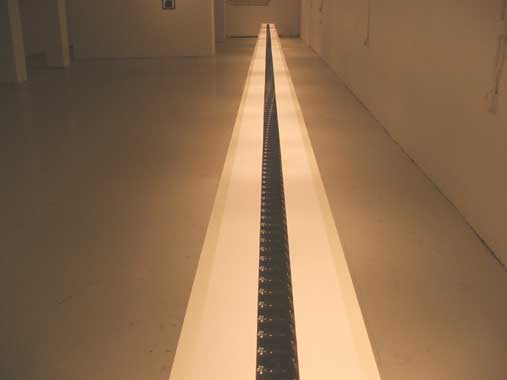.jpg) |
| Theo Sims: Space , installation shot, Golden Thread Gallery; courtesy the artist |
Some 80 feet in length, horizontally displayed, a set of computer-aided digital photographic prints, each smaller than a postcard, serenely parallel the right angles of the larger of the two galleries. Visibly connected, three rolls of paper embed the images of a pub, images born from a scanning, panning movement of the ciné or video camera. Each frame has been digitally printed and consecutively placed. The artist took the photographs in the normal way, standing, facing the interiors and the objects. He has displayed them not vertically, but as a horizontal torrent of flat surfaces. Looked at from one end, the eye does not read the actual objects, just patterns. The images originated between two parallels, the lens and the upright world, both vertical. The display collapses two of the three dimensions into the third, the horizontal one. What is the point of this? In somewhat irreverent manner this strategy refers to one of the Modernists’ obsessions, both approving and changing it. Also, it strikes me as a lively application of Merleau-Ponty’s "lived body", which turns a volume into a flat time-space continuum.
 |
| Theo Sims: from Space ; courtesy the artist |
On first sight, the small scale of each frame is reminiscent of an old tradition of objects, like special editions of poetry, family photographs, and, on a more elevated level, Books of Hours. Instead of the contemplation of eternity, the banal normality of the pub-crawling generations stands for the most important event in life. The disconcerting abandonment with which the interior is seen and unseen at the same time, in the same frame, ignites a doubt – maybe the pub is just the frame for another, significant and serious event, which shyly hides under that banality. By this I mean the difference between the lens documenting the shades of colours and the eye being denied assured recognition as to what exactly it is looking at. The recognition, for example, of a dark figure sharing a table is so delayed that when it becomes clearer, it acts as a revelation. I find it gently humorous, this demand to persevere when all looks so empty, until the void is filled by a meaning. That such recognitions come almost as accidental anecdotes reminds me of laughter as cognition, laughter as a critique of perception. If I am right, in sensing cognition and identity as the real issue here, then my initial hunch that the work leans towards phenomenology is supported.
 |
| Theo Sims: Space , installation shot, Golden Thread Gallery; courtesy the artist |
Another insight occurred after Theo Sims e-mailed me this:
… the bar in the photo is in Winnipeg … this really only being half of the entire show (the show is placed and displaced). There was a participatory performance piece held here in Winnipeg. The bar is my local, however none of the regulars are involved in the arts scene here. With tongue firmly in cheek, I called on members of the Winnipeg arts scene to appear in a film in the bar where they had to act by playing themselves sitting in the bar and drinking beer. The film was 8 seconds long and the rent-an-audience stayed for several hours after.
The basis is a narrative, narration, telling about the experience of being in that place / space. In slow footsteps from left to the right, maybe no footsteps at all, just turning the hand that held the camera, the space is cut into right-angled frames, its fluency dismissed. And then it can happen, the transformation, the displacement of the first reading, of the first seeing of the pub as a place with furniture and people and signs and the vernacular of that culture. The items of the place, like a light or a sign, are catalogued in consecutive frames. As I moved away from the top, my memory of the frames diminished and instead I received ‘another view’- e.g. of a blue light tracing its paths from the right to the left with all the other objects following. Before they disappeared from the frames, they contributed to a pattern. When I reached the end, several patterns of coloured pathways were all there was. No pub, no space, no place. Just ‘splace’ – the polylogic narrative turning into a design for tweed. Or – given the thought that it is only half of a show, some threads – for the Golden Thread – of half of a DNA strand. Playful? Yes, but with a darkened resolve to let the visual screech out its critique. Sims’ emphasis on dual problematics, encountering objects and reflecting on objects as they are encountered, is an accepted phenomenological approach. The critique is soft and seductive at first, submissive to ordinary uneventful existence, and once this seems stable, all twists and changes into an alien abstraction that erases the first perceptions. The only condition for the second perception is dislocation, moving away, moving along, using the dynamics of space. Sims gives this strategy full rein. It is connected to his own experiences. Sims was born in Chailey, England, in 1969, went through Foundation Studies at Winchester in 1988-9, moving to study for a BA (Hons) at Brighton 1989-92 and an MFA in Belfast in part-time mode during 1992-94. He relocates, leaving marks in his art practice and through it in the visual culture of each place. Such a dual bind could be exploitative, as the history of colonising others would illustrate. Instead he gives back – taking a tiny fragment of Winnipeg to Belfast so deliberately that he asked a neon maker in Belfast to reproduce a Winnipeg beer sign "as he saw it" – cutting off the two letters OV from the original context. Some read it as ‘ CV’ , I am told. Life instead of beer.
 |
| Theo Sims: from Space , neon sign; courtesy the artist |
"Di(splace)ment," he wrote in a way of explanation for the installation.
I asked Sims whether the name of the exhibition is a reference to James Joyce. He e-mailed me his answer:
Whilst not deliberately making a connection to Joyce, I think there has always been a fascination there and subconsciously some of that may have crept in … it was a tip of the hat to Michael Wilson and a show called ‘fast . I have been influenced by some of the ideas involved behind his bedroom gallery that was on Greenore St.
At this moment I have no understanding of the influence of Wilson; however, thanks to Christa Maria Lerm Hayes’ seminal work Joyce in Art I connect ‘splace’ (space and place) to the indirect mode of influence (op.cit., p. 133), as allowed by Sims’ answer.
I have, also, looked up ‘splace’ on the internet using a number of search engines. The result is interestingly unfocused: two American poets use it in the name of their website, a mathematicians’ forum uses it when trying to solve an Eternity Puzzle; a binary search cannot solve it, so they think of "some other approach, maybe splacing pieces in a different way." "Splacing" appears also as a term in photography: e.g., "splacing tape dispenser." They all look like typing errors, maybe even deliberately so. Very apt – Sims deliberately uses pub scenes to get at the social and psychological hang-ups in our perceptions, unsettling certainties. I can use some of that to unlock some of Sims’s meanings: splicing the film’s frames not in time, but in space, in a silent, static display, he makes a puzzle: a life situation becomes identical with an abstract pattern, like identical twins. Not only have we half of a show, not only is the real community of locals displaced by artists who are not actors, acting themselves, the whole trace of it all transforms itself to several snaking patterns, pretty, geometrical and utterly devoid of fixed meaning, yet associating with the double helix (here only half of it) of deoxyribonucleic acid, the sequence of which determines what is inherited. Here, what becomes a past, a history, a memory.
The fact that something mimetic, rooted in likeness, may, without repetition or a dropped repetition, produce a pattern akin to a weave and thus become an abstraction is in a strong opposition to the binary approach favoured by, for example, Wassily Kandinsky and Piet Mondrian. "The cultivated man of today is gradually turning away from natural things, and his life is becoming more and more abstract," wrote Mondrian in 1919 ( De Stijl , cited in H.Chipps). In addition, Kandinsky rejected geometric abstraction, favoured by Mondrian. Sims embraces the ability of consecutive steps in space to translate something real into a torrent of coloured patterns, curves regulated by right angles, a method favoured by Mondrian. Kandinsky’s inner image and symbolic values of hues do not come near to Splace – or do they? Sims’ intention has been complex, and locked in his consciousness, as an inner image might be. The colours of neon signs do not have the power to evoke a state of mind like the blue, yellow and red in Kandinsky’s theories, but the colours in the photographs do produce a state of being associated with contemporary, ordinary western pubs.
Contextually, the work’s sources are in Winnipeg, as is the artist. The new context, the Golden Thread Gallery, adapts well to the needs forged by the work’s size. Conceptually, the work is slightly autobiographical and strongly phenomenological. The real is and is not at the same time, our access barred by the distances between the model and the trace, and the trace and the viewing point. A splendid example of the fickle nature of contexts. It makes a good case for concepts’ creative dynamics.
Slavka Sverakova is a freelance writer on visual art.